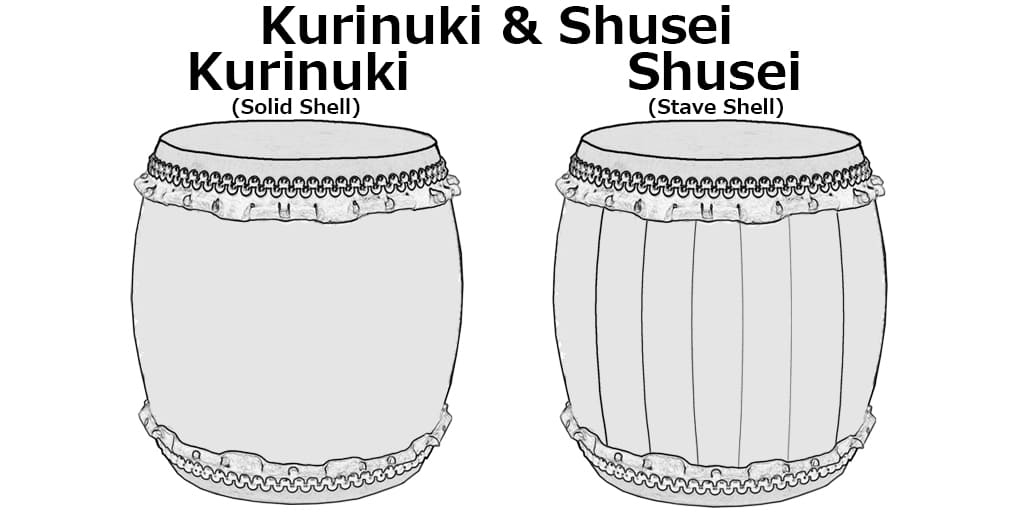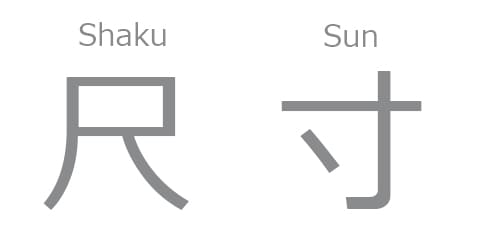1. Nagado Daiko
Nagado daiko is the most popular type of taiko also called miya daiko and odaiko. The best material is keyaki wood, Japanese zelkova wood. There are a wide range of the nagado daiko from the low price one to the excellent one. In addition, the metal parts are also important in the respect of the look.
Construction:
Traditionally, it's hollowed out of a log, which is cut in proper length. Craftsmen used to use chisels to hollow it in the old time, but now they use machines to hollow, whittle and polish the body.

Kurinuki (Hollowed-out Solid Shell): It is original structure, which is made of one piece of wood. It's the excellent because of not only the beautiful grain of the wood but also the deep and reflecting sounds produced inside the thick and hard wood.
Shusei (Stave Shell): It is constructed by wooden boards. There are not so many suitable wood for kurinuki available in these days. Also, based on the high technique to make the taiko as good as the kurinuki taiko, shusei type is becoming popular. It has relatively reasonable price and the light weight is one of the reason why it's popular.
Wood:
Keyaki (zelkova) is the best. It's very hard and hardly scratched. Also, the grain is beautiful. Moreover, once studs to fasten taiko heads are driven into the keyaki body, they hardly come loose. Tamo (ash), sen (kalopanax), kusu (camphor) are also popular woods for taiko. However, it's getting difficult to get logs of those woods, which is big enough to become a taiko body in Japan. Thus, imported alternative woods are often used to make a large taiko.

Keyaki (Japanese zelkova): Keyaki is the best material of the taiko body.
Meari (Second best wood): Meari is the term for the second best material such as tamo (ash) and sen (kalopanax).
Other Material: Other than keyaki and meari, there are some taiko made of the various wood like matsu (pine), buna (beech), bubinga, and take (bamboo).
Skin:
Usually, cowhide is used for drum head. The cowhide of a three-years-old female Japanese cow is said to be the best material. Horsehide is often used for the katsugi oke daiko. A skin of water buffalo is used for the head of a larger taiko.

Mimi: Literally, it means ear in Japanese. In taiko terminology, it means the hem of the head produced after studding (It's also called en). Usually, the cowhide is stretched over the top of body with ropes, which are laced through holes of the hem. Mimi used to be cut off after studding, but nowadays people leave it intentionally. When the head gets loose after using for years, it can be tightened up again if the mimi remains, instead of replacing the whole head.
Quality: Taiko heads are made of cowhide tanned by craftsmen with their secret technique. The cowhide is cut in proper size and is stretched over the top of a taiko body using special equipment. Usually, taiko heads made of cowhide have some brown spots. Nowadays, some taiko makers bleach them for sightly sake, sacrificing their durability. The sound of the brand-new skin is high-pitch and it gets lower as it's played. Taiko players make the sound of their taiko by playing it again and again.
 |
Do you know the types of taiko? See also this article.
|
 |
Do you know how to maintain taiko? See also this article.
|
2. Shime Daiko
Shime daiko (tsukeshime daiko) consists of a body, heads, and a rope or bolts. A membrane is tied with rope or bolt along the body.

Rope Jime: It is the traditional look of the shime daiko and tuned by a rope.
Bolt Jime: It is tuned by bolt and nut and easy to tighten and loosen. So shime daiko needs to be loosened after use, it is more convenient than rope jime.
Turnbuckle Jime: Turnbuckle is easier to tighten and loosen than bolt jime.

Wood:
Same as nagado daiko. Keyaki (zelkova) is the best material of the wood that makes the best sound.
Skin:
Skin of the shime daiko is cowhide. The iron ring is inside the rim part of the shime daiko head.
3. Katsugi Oke Daiko
Katsugi oke daiko is a kind of okedo daiko, the body of which is made of the stave shell like oke (Japanese wooden tub and bucket). Compared to the nagado daiko (making deep and low-pitch sounds) and the shime daiko (making sharp and high-pitch sounds), it makes medium-pitch sounds.

Difference Between Okedo and Katsugi Oke: Katsugi oke is different from okedo daiko in some respects. First, the playing style of katsugi oke and okedo is different. Katsugi oke is hung with a strap from the player's shoulder. On the other hand, okedo is set on the stand. Second, the katsugi oke is made of light material so that the player carry it easily. Third, the katsugi oke's drum head is made of thinner than okedo's. So, do not play with hard bachi.
Wood:
Body of the katsugi oke daiko is made of the light wood like kiri (paulownia) so that the player hang it from the shoulder.
Skin:
There are two types of the skin for katsugi oke daiko.
Horsehide and Cowhide: The most obvious difference is the sound. The horsehide head is generally said to produces a brighter sound than cowhide. Cowhide is more durable than horsehide. The both are used commonly. taiko players seem to choose one matching their need. *Horsehide is temporally unavailable.
4. Eisa Daiko
Eisa is music with dance originally performed in Okinawa. It was originally a traditional folk performance for a memorial service for their ancestor's spirits. It is close to the obon event in Japan mainland. Three drums are used in eisa music and dance.

Eisa Odaiko: Eisa odaiko is a special taiko used for eisa dance. It is very light that the performers carry it with a sash. Players perform it with eisa dance energetically. The material is soft and more fragile than other taiko like nagado daiko which is made of the durable wood and skin.
Eisa Shime Daiko: The eisa performers hold taiko with one hand and strike it with a bachi. This shime daiko is very light, and performers play and dance while swinging it. This dynamic playing style is unique for eisa. Eisa shime daiko is made of the soft and light material than shime daiko (tsuke shime daiko).
Paranku: Paranku is a key instrument for eisa dance in Okinawa. Eisa performers hold it with one hand and strike it with a bachi with the other hand while dancing energetically. As well as other eisa drums, the material is not so durable.
😚Thank you for reading this to the end. Please feel free to ask any questions or leave any comments😉







































































